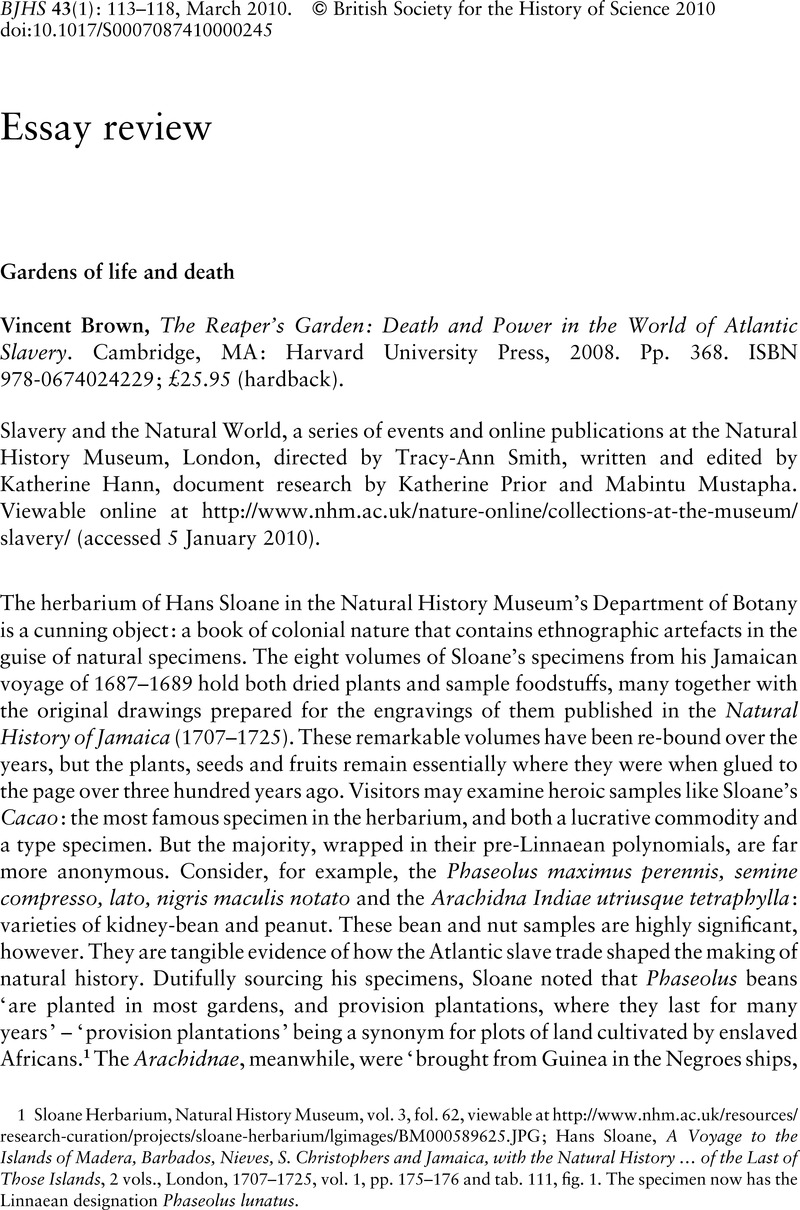No CrossRef data available.
Article contents
Gardens of life and death
Published online by Cambridge University Press: 09 March 2010
Abstract

- Type
- Essay Review
- Information
- Copyright
- Copyright © British Society for the History of Science 2010
References
1 Sloane Herbarium, Natural History Museum, vol. 3, fol. 62, viewable at http://www.nhm.ac.uk/resources/research-curation/projects/sloane-herbarium/lgimages/BM000589625.JPG; Hans Sloane, A Voyage to the Islands of Madera, Barbados, Nieves, S. Christophers and Jamaica, with the Natural History … of the Last of Those Islands, 2 vols., London, 1707–1725, vol. 1, pp. 175–176 and tab. 111, fig. 1. The specimen now has the Linnaean designation Phaseolus lunatus.
2 Sloane Herbarium, Natural History Museum, vol. 3, fol. 85, viewable at http://www.nhm.ac.uk/resources/research-curation/projects/sloane-herbarium/lgimages/BM000589663.JPG; Sloane, op. cit. (1), vol. 1, p. 184. The specimen now has the Linnaean designation Arachis hypogaea, and is attributed to the Harrison Sloane spoke of. Both the Phaseolus and the Arachidna are in mentioned in William Grimé, Ethno-botany of the Black Americans, Algonac, MI: Reference Publications, 1979, 19–20.
3 Grimé, op. cit. (2); Judith Carney, Black Rice: The African Origin of Rice Cultivation in the Americas, Cambridge, MA: Harvard University Press, 2001; Londa Schiebinger, Plants and Empire: Colonial Bioprospecting in the Atlantic World, Cambridge, MA: Harvard University Press, 2004; Karol K. Weaver, Medical Revolutionaries: The Enslaved Healers of Eighteenth-Century Saint-Domingue, Urbana: University of Illinois Press, 2006; Susan Scott Parrish, American Curiosity: Cultures of Natural History in the Colonial British Atlantic World, Chapel Hill: University of North Carolina Press, 2006, Chapter 7; James Delbourgo, ‘Slavery in the cabinet of curiosities: Hans Sloane's Atlantic world’, British Museum (2007), at http://www.britishmuseum.org/pdf/delbourgo%20essay.pdf.
4 The phrase comes from the discussion entitled ‘On Obi; or African witch-craft’, in Benjamin Moseley, Medical Tracts, London, 2nd edn, 1800, pp. 189–199. Moseley, an Essex physician who spent several years in Jamaica, identified Obeah with the pernicious work of the imagination in ancient magical traditions, animal magnetism and Euro-American witchcraft scares, conversely describing witchcraft as a form of ‘Obi in England … for which many old women have been tried’.
5 Orlando Patterson, Slavery and Social Death: A Comparative Study, Cambridge, MA: Harvard University Press, 1982.
6 Beth Fowkes Tobin, Colonizing Nature: The Tropics in British Arts and Letters, 1760–1820, Philadelphia: University of Pennsylvania Press, 2005, pp. 56–80; Jill Casid, Sowing Empire: Landscape and Colonization, Minneapolis: University of Minnesota Press, 2005, pp. 191–236.
7 For critical remarks on the 2007 commemorations that address the relation between academics, museum specialists and the general public see Katherine Prior, ‘Commemorating slavery 2007: a personal view from inside the museums’, History Workshop Journal (2007) 64, pp. 200–211.


